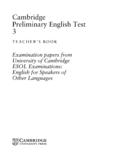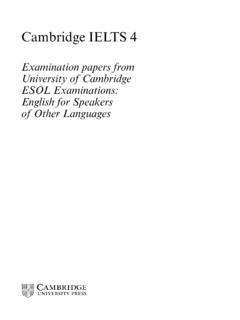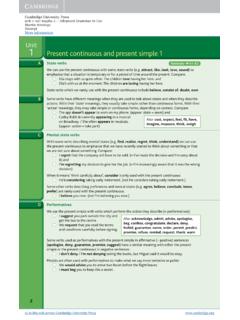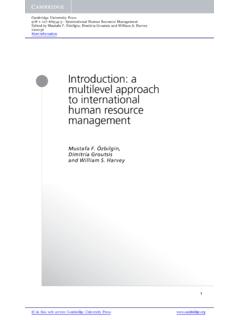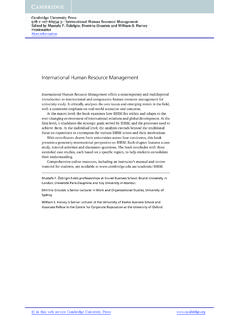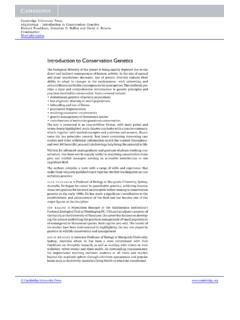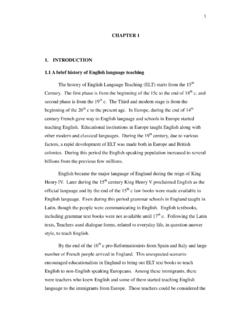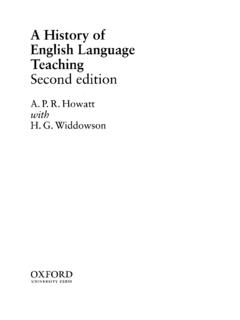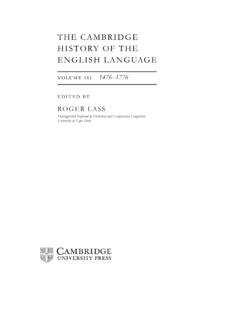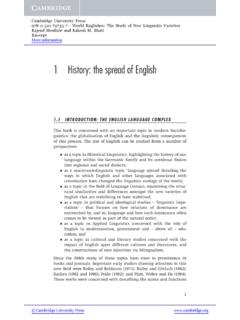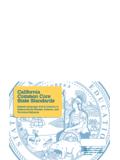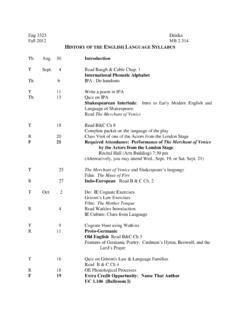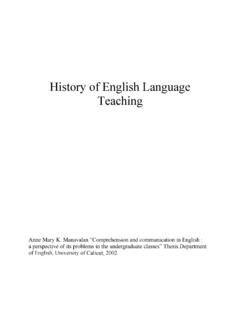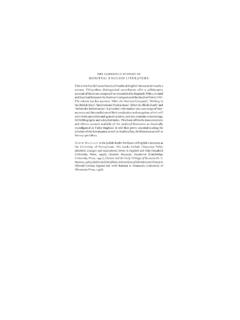Transcription of THECAMBRIDGE HISTORYOFTHE ENGLISHLANGUAGE
1 THE CAMBRIDGEHISTORY OF THEENGLISH language english in North America JOHN ALGEOP rofessor Emeritus, University of Georgia ThePittBuilding,TrumpingtonStreet,Cambri dge,UnitedKingdom TheEdinburghBuilding,CambridgeCB22RU,UK4 0 West20thStreet,NewYork,NY10011-4211,USA4 77 Williamstown Road,Port Melbourne,VIC3207,AustraliaRuizdeAlarc n13,28014 Madrid,SpainDockHouse,TheWaterfront,Cape Town8001, relevantcollectivelicensingagreements,no reproductionof anypartmaytakeplacewithoutthewrittenperm issionof 2003 PrintedintheUnitedKingdomattheUniversity Press,CambridgeTypefaceMonotypeGaramond1 1/13ptSystemQuarkXPress [ ]A catalogue record for this book is available from the British LibraryISBN0521264790hardbackCONTENTSLis t of contributorspageixGeneral Editor s prefacexiVolume Editor s prefacexvAcknowledgmentsxxviiiExplanator y notesxxixPronunciation symbolsxxx1 EXTERNAL HISTORYJohn history , Periodsinthehistoryof TheInternationalperiod372 BRITISH AND AMERICAN, CONTINUITYAND DIVERGENCEJohn Hurt Thecontinuityof Nationalism,AmericanEnglish, Literature,writing, BritishandAmericaninterrelations84v3 BRITISH AND IRISH ANTECEDENTSM ichael Sourcesof Historicaldevelopmentof Researchneedsandconclusions1514 CONTACT WITH OTHER LANGUAGESS uzanne Pre-contact:languagesbeforeEnglishinNort hAmerica Majorlanguagesof Conclusion1815 AMERICANISMSF rederic G.
2 Cassidy andJoan Houston Conclusion2166 SLANGJ onathan E. Radiationsof themeaningsof Thehistoricaldevelopmentof Theroleof slanginAmericanlife2497 DIALECTSLee Summary:majorAmericandialects2898 AFRICAN-AMERICAN ENGLISHS alikoko S. WhatisAfrican-AmericanEnglish? Featuresof Thedevelopmentof Benefitsof Futurestudiesof AAE3229 GRAMMATICAL STRUCTURER onald R. American IndependentchangesinstandardAmericanEngl ishgrammar33510 SPELLINGR ichard L. Spellingrefor Conclusion356 Contentsvii11 USAGEE dward Theoriginsof thestudyof Closingthegap:scholarsfacethefactsof Conclusion41812 CANADIAN ENGLISHL aurel J. Brinton andMargery Speakersof Thestudyof Linguisticfeaturesof Conclusion43913 NEWFOUNDLAND ENGLISHW illiam J. Conclusion45414 AMERICAN english ABROADR ichard W.
3 Emergingawarenessof RisingBritishanxietyandantagonis Thetriumphof AmericanEnglish493 Glossary of linguistic terms497 Bibliography516 Index568 Contentsviii EXTERNAL HISTORYJohn ,external and internalThe history of a language is intimately related to the history of the commu-nity of its speakers, so neither can be studied without considering the external history of a language is the history of its speakers as theirhistory affects the language they use. It includes such factors as the topog-raphy of the land where they live, their migrations, their wars, their con-quests of and by others, their government, their arts and sciences, theireconomics and technology, their religions and philosophies, their trade andcommerce, their marriage customs and family patterns, their architecture,their sports and recreations, and indeed every aspect of their is so basic to human activity that there is nothing human beingsdo that does not influence and, in turn, is not influenced by the languagethey speak.
4 Indeed, if Benjamin Lee Whorf (1956) was right, our verythought patterns and view of the world are inescapably connected with is, of course, possible to view the history of a language merely as inter-nal history a series of changes in the inventory of linguistic units (vocab-ulary) and the system by which they are related (grammar), quite apart fromany experiences undergone by the users of the language . We can describehow the vocabulary is affected by loanwords or how new words are derivedfrom the language s own lexical resources. We can formulate sound lawsand shifts, describe changes that convert an inflected language to an isolat-ing one, or a syntax that puts an object before its verb to one that puts theverb before its object. That is, we can describe a language purely as a formalobject. But such a view will be abstract, bloodless, and often lacking inexplanation for the linguistic language is a human capacity, the history of a particular languageis linked with that of its speakers.
5 As a part of a total culture, a language1cannot be completely separated from the culture of which it is a part. Toextend Meillet s dictum cited by Salikoko Mufwene (at the end of ), aculture is a system in which everything hangs together. Therefore to under-stand the whole culture, we must understand the language ; and vice versa, tounderstand the language , we must understand the culture. The effort to tracethe history of a linguistic system and its units (lexical, phonological,morphological, and syntactic history ) is the diachronic aspect of microlin-guistics. The effort to trace the history of the speakers of that language isthe diachronic aspect of chapter does not offer a history of America, but rather a briefaccount of political and social events that can reasonably be seen as havinghad a significant influence on the english language .
6 Some events of greatmoment in other ways are therefore treated lightly or not at all, and otherevents of small import in themselves, but with consequences for the lan-guage, are treated at greater length. The difference between the two kinds ofevents is, to be sure, a matter of respect to the events it reports, the aim of this chapter is that ofMax Lerner (1987, xvi) in his cultural history of America not to presenteither a rosy and euphoric picture seen in a haze of promise or an unspar-ing indictment but rather to avoid both these sins .. the sin of compla-cency and the sin of self-hatred. The external history of American english has involved a number offactors with profound effects on the language : population mobility, innova-tion, discontinuity with the past, decentralization, democracy, a large landarea, and a large and ethnically diverse among those factors is mobility.
7 The colonists were by definition amoving population, but as settlers they did not simply settle in. Rather theycontinued moving. Americans have consequently always been a peripateticpopulation. The history of America has been described as one of anexpanding frontier, from the first settlements along the Atlantic coast to asmall step for a man onto the surface of the second factor follows from the first: mobility requires adaptabilityand innovation. Change of location requires change of lifestyle. The firstcolonists could not live in the New World just as they had in the Old. Theyhad to adapt. Later immigrants likewise had to adjust to the new conditionsthey found. Change and adaptation became hallmarks of American became the norm of American life in social structures, tech-nology, and led to a third factor: a sense of discontinuity with the pastand of perpetual youth.
8 We can never be actually separated from our past,John Algeo2but a perception of separation affects our view of ourselves. American lifeand language are, to be sure, unmistakable continuations of the life and lan-guage of England. And, indeed, in certain respects, Americans have beenmore conservative than Britons. But in other respects they are less boundto former ways. The emphasis of the New World has been on itsnewness and its break with the Old World. Immigrant populations typicallyretain a sentimental attachment to the old country, but assimilate into thenew pattern of life, while inevitably changing that pattern by their assimila-tion. The result is a perpetual sense of newness. In Oscar Wilde s bon mot, The youth of America is their oldest tradition. It has been going on nowfor three [today four] hundred years. Another consequence of mobility has been decentralization.
9 The verystructure of American government is one of a federal union of states,which retain certain prerogatives and rights. On many matters, there is nosingle American law, but fifty different laws. So also, though Washington,DC, is the governmental capital of the nation and New York City is a com-mercial capital, there is no cultural capital in the nation. No location in theUnited States corresponds to London as the center of the related factor is that of democracy or, perhaps more accurately, socialmobility. The latter term s first recorded use in the OEDis from 1925, byPitirim A. Sorokin, founder of the Department of Sociology at Harvard: We used to think that in the United States .. social mobility was greatest. Equality of life in America can be and has been exaggerated. Classdifferences certainly exist, based on wealth, fame, education, profession,connections, and other such factors, although they may be less clearlydefined and more permeable than in some other places.
10 But there is noinherited American aristocracy to rule or serve as a model. It is part of theAmerican myth that the only aristocracy in the land is one of merit. Mythsmay be untrue, yet they are powerfully physical size, the United States is nearly as large as the entire Europeancontinent, with even greater variability in climate and topography. The sheersize of the country presents english speakers with a wide environment torespond to and with extensive resources to draw on. The major stages ofterritorial expansion of the United States after the post-Revolutionary set-tlement with Britain at the Treaty of Paris (1783) were the LouisianaPurchase from France (1803), the Florida cession by treaty with Spain(1819), the admission of the Republic of Texas (1845), the Oregon acquisi-tion by treaty with Great Britain (1846), the Southwestern cession by con-quest from Mexico (1848), the Gadsden Purchase of territory in southernExternal history3 Arizona and New Mexico from Mexico (1853), the Alaska Purchase fromRussia (1867), and the annexation of the Republic of Hawaii (1898).
